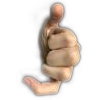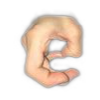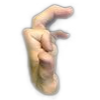The Tortured Artist
October 23rd 2024
Consistently maintaining a high level of creative output is a holy grail of mine. Some days ideas develop into projects without so much as a hitch and in these moments it feels like all my prayers could be answered; some weeks I am at the mercy of a lethargic mind. Desperate for inspiration, I'll read op-eds and poems until text takes on a hieroglyphic quality and consume avant-garde media until it becomes too pretentious for my liking. For all my efforts, there is no guarantee that I'll induce anything other than frustration.
This is a real shame since creative generation should have a place on Maslow's hierarchy of needs - perhaps sitting interchangeably with self-esteem. When done right, it glues me together and reassures me I am not too scattered to be whole. The catharsis of being able to translate raw experience and sensation into tangible work is second-to-none.
And so, driven by baseless optimism, I often attempt far-flung strategies for cognitive optimization. Most are minimal risk - like my two-month fling with ashwagandha supplements. Miraculous promises of increased focus, cognition, sleep quality, and muscle tone were left undelivered. Disappointing, but not devastating; I only wagered $15 for the bottle.
Along this search for the cure-all to creative lulls, I happened upon an interview with Jesse Eisenberg - actor and filmmaker best known for his lead role in 2010's The Social Network. He preaches his approach to achieving career milestones wherein he allows his anxiety and self-hatred to create an all-consuming drive to prove himself. After all, there is no greater motivator than fear.
I bite. I have always been of the mindset that if I'm not ahead, I'm behind. Productivity is the gold standard of one's worth, and I have not matched the prowess of my peers. I have heaps of self-doubt and emotional unease to draw from. I am the perfect candidate for this drive-hard crash-hard philosophy.
Another thing I am is not very emotionally proficient. The more I learn about how I process, store, and personify salient events, the more I realize the extent of my ignorance. I accept this now, but it has taken time and humility to do so. I discovered the interview before this epiphany, figured the Eisenberg philosophy was minimal risk.
The months that followed were defined by an ever-present sense of dread as I welcomed my anxiety, recklessly and indiscriminately coaxing out fears from my endeavors. And would you believe it, this strategy worked wonders when my productivity was up to par. I would meet my expectations in sprints, coerced by the thrill of keeping my head above water for days at a time. I was on the knife's edge; this system only worked so long as I feared the consequences of it falling apart.
And of course, it eventually falls apart. I can only account for so much uncertainty and I can only handle so much stress. I fell behind on my objectives as other responsibilities demanded my attention. Pressure swelled for every missed opportunity to catch back up. This debt accrued until it began to paralyze me. I learned to abhor the idea of doing anything, resolving this debt in reasonable time seemed to require an inhuman effort. Fervor for creation all but evaporated, I entered a slump that demanded I be more forgiving to myself in order to be rectified. This particular experiment in harnessing creativity was an unmitigated disaster.
Meaningful work requires suffering; blood and tears translate directly into impact and magnitude. This is the tortured artist fallacy. Now, it is true that the staying power of some timeless artists are at least partly the result of the struggles that defined them. Vincent Van Gogh's endless bout with depression, Ernest Hemingway's chronic pain and alcohol abuse, Frida Kahlo's injuries from a traffic accident, and so on. Moreover, some of the most respected artists neglect their own health and personal relationships in pursuit of perfecting their crafts. Van Gogh epitomizes this with "I put my heart and my soul into my work, and have lost my mind in the process". The fallacy is not that suffering entails memorable affect, after all there are far too many hit songs about heartbreak for this to be false. Instead, the fallacy is that suffering is necessary to convey affect.
This is perhaps best exemplified by director David Lynch's statement that he stopped seeing a therapist after being warned that it could affect his creativity. Such a perspective is not uncommon, the trope of the tortured artist implies that creativity arises from mental instability. Consider this idea for more than a moment and bask in it's ridiculousness.
Mental illnesses are not quirks of perspective. They are the culminations of complex interactions between physiological and emotional factors. Over 450 distinct mental disorders are currently recognized by the standardized diagnostic guide published by the American Psychiatric Association. We have a cure for none of them. Depression cannot do for creativity what tapeworms do for weight loss - there is no guarantee that it can be shaken off once it has reached the end of its utility.
Besides, the evidence points towards mental instability as a detractor of creativity. Literature reviews conducted in 1998 and 2014 both find a lack of positive correlation between creativity and mental disorder [1][2]. A study of 150 creatives instead uncovers a strong positive correlation between mental wellbeing and creativity [3]. Art is not an exhibition for madness as common sentiment often surmises. It is a tool of healing and reconciliation for one's troubles. Producing art has been proven to be therapeutic, minimizing the magnitude of anxious and depressive tendencies [4]. This flips the causation conjecture of the tortured artist fallacy; artists are not driven mad by their work, but are instead troubled by their circumstances and find solace in producing art.
The 'tortured artist' still makes for a sensational story. A misaligned commitment to craft, it is heartbreaking and so potently human. But for all our love of telling stories, the division between fact and fiction is easily lost. My subscription to the idea that suffering makes an artist led to developing negative habits of thought that I am still unravelling. There is simply no need to continue burning out creatives with this myth. Fact: there is no greater boon than self-compassion.
References
1. Waddell, Charlotte. “Creativity and Mental Illness: Is There a Link?” The Canadian Journal of Psychiatry, vol. 43, no. 2, Mar. 1998, pp. 166–172, journals.sagepub.com/doi/10.1177/070674379804300206, https://doi.org/10.1177/070674379804300206.
2. Thys, Erik, et al. “Creativity and Psychopathology: A Systematic Review.” Psychopathology, vol. 47, no. 3, 2014, pp. 141–147, https://doi.org/10.1159/000357822. Accessed 10 Mar. 2019.
3. Smith, Kaile, et al. “The Creative Life: A Daily Diary Study of Creativity, Affect, and Well-Being in Creative Individuals.” Creativity Research Journal, vol. 34, no. 4, 19 Sept. 2022, pp. 1–20, https://doi.org/10.1080/10400419.2022.2122371.
4. Sandmire, David Alan, et al. “The Influence of Art Making on Anxiety: A Pilot Study.” Art Therapy, vol. 29, no. 2, June 2012, pp. 68–73, https://doi.org/10.1080/07421656.2012.683748.


